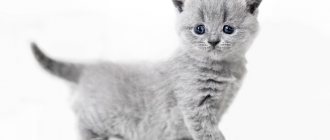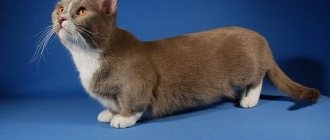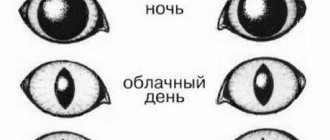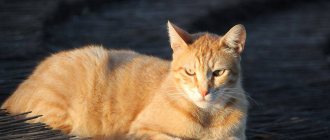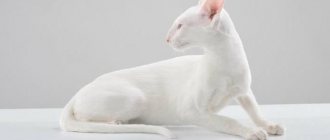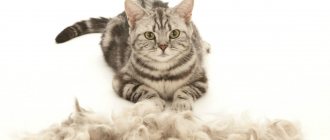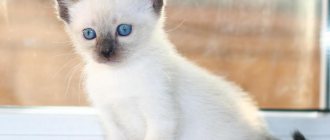Why doesn't carbon paper have red spots?
As is known, cats, like other female mammals, have two X chromosomes in their genome.
And it is in them that the gene responsible for coat color is located. The gene has two alleles - red and non-red (black) color. In a zygote, a cell formed by the fusion of an egg and a sperm, both X chromosomes are active. During cell division and subsequent differentiation in all cells of the body, including future pigment cells, one of the X chromosomes is inactivated. If a cat is heterozygous for the color gene, then in some cells the chromosome carrying the red color allele can be inactivated, in others - the chromosome carrying the black color allele.
https://www.youtube.com/watch?v=iGjYg6NYalA
The world's first cloned cat Kopirka does not look like either her surrogate tabby mother (photo above) or her genetic original tortoiseshell color (photo below) - she does not have red spots, as cats of this genotype are supposed to. Photo by L. Wadsworth.
Siamese replacement
Twenty years ago, the genetic map of a cat's chromosomes contained only a few dozen genes; now their number is approaching two thousand. In particular, color genes have been mapped and deciphered and critical points have been identified, mutations at which lead to color changes.
So, on one of the somatic
(non-sex) chromosomes, two mutations are localized by color.
The dominant white color mutation, located in the c-kit
, disrupts the ability to migrate in
melanoblasts
, the precursors of embryonic pigment cells. And since melanoblasts do not have time to reach the skin in time, the pigment does not get into the hairs. As a result, the fur grows completely white. If sometimes melanoblasts still manage to penetrate the hair follicles located on the cat’s head, then small colored areas appear there. In carriers of this mutation, the number of melanoblasts that reach the retina may vary. If there are a lot of them, then the eyes will have a normal yellow color, if there are very few - blue.
On the same chromosome there is a gene that determines the color pattern. Normal allele
(structural form) of this gene gives the striped, brindle coloration.
Sometimes these stripes are continuous, sometimes they are broken. The semi-dominant mutation Abyssinian tabby
.
In homozygotes
(i.e., in individuals with a pair of identical alleles) for this mutation, no stripes are found on the body: the animals have a uniform color.
But in heterozygotes for this mutation, stripes are located on the tail, muzzle and paws. A recessive mutation in the same gene - marbled tabby
- turns the transverse stripes into curls or irregularly shaped streaks. Often such cats have a wide black stripe running down their backs.
For albinism
– a phenomenon widely found in different species of mammals – there are mutations in the gene encoding the enzyme tyrosinase. In this case, the synthesis of the enzyme is either completely blocked, or a defective enzyme with altered activity is synthesized.
Several such mutations have been described in cats. In homozygotes for the Burmese albinism
Tyrosinase activity is slightly reduced compared to normal. Moreover, the degree of suppression of enzyme activity depends on body temperature: at a lower temperature than normal, it is more active. This is why Burmese cats have more intensely colored areas of fur on the tips of their paws, tail, ears, and nose, that is, in those areas of the body where the temperature is low.
The same can be said regarding the Siamese albinism
. However, the level of depigmentation is much higher: in Siamese cats, the hair on the body, as a rule, has no pigment, and the color remains only on the tips of the paws, tail, ears and nose. But even these areas are less pigmented than in Burmese cats. The eyes are usually blue due to a decrease in the amount of pigment in the retina.
Now we know exactly the molecular nature of these mutations: they are obtained due to the replacement of a single nucleotide in the gene sequence! In Siamese cats, the nucleotide at position 422 from the beginning of the gene is replaced in the gene responsible for the synthesis of tyrosinase. Normal cats have guanine there, while Siamese cats have adenine. As a result, the nucleotide sequence encoding the amino acid arginine was converted into a sequence encoding glycine. Replacement of arginine with glycine in the tyrosinase protein led to a decrease in its enzymatic activity at normal body temperature.
In Burmese cats, a similar weakening of body color is due to a nucleotide substitution at position 227.
The principle of inheritance and what do cats inherit?
Genetic information passed down from ancestors is called genotype. Its external manifestations are phenotype. Genes are combined in pairs, one from each parent and may include dominant - strong, the signs of which will appear in the descendant, recessive - weak, which remain hidden in the body.
Chromosomes pass on information to the descendant that is responsible for:
- location, shape and size of ears;
- color, length, coat structure;
- shape, length and thickness of the tail;
- diseases.
Patterns of gene inheritance are used by specialists to breed cat breeds with specified characteristics. But it would be a mistake to believe that this requires only knowledge of genes, what traits they are responsible for, and the basics of breeding work. In practice, it is necessary to know the fundamental mechanisms of gene operation, which have not yet been sufficiently studied.
At the same time, combinations of genes complicate and expand the possibilities of breeding new breeds, which 20 years ago there were only about 20, but today there are more than 2 thousand. Of primary importance when selecting and culling individuals for purebred breeding is the consideration of the chromosome complex of cats. In this case, all deviations found in it, as well as flaws in appearance, are taken into account.
Sometimes mutations occur in the set of chromosomes, and cats are born with deformities in appearance or with Down's disease. It is possible to make a forecast regarding the first phenomenon, but with the second it is more difficult, since there are not many studies on the possible origins of this disease.
Genetics is a fairly young science that studies the mechanisms of inheritance of certain traits by living organisms, as well as the laws and patterns of this inheritance. Decoding the cat gene helps to find out how many chromosomes cats and other animals have, what kind of offspring an individual will produce, prevent the continuation of negative mutations and help maintain the purity of the breed.
Interesting things about cats are collected in this video
Down syndrome in cats
Since cats also have chromosomes, it is not strange that this pathology occurs in them too. Like people, sick cats also differ from healthy cats in their characteristic eye position and facial expression.
Down syndrome occurs when an extra unpaired chromosome appears in the karyotype. Accordingly, in sick cats there will be 39 of them, and not 38, as in healthy ones. Individuals with 20 pairs are extremely rare. This is largely due to the fact that cats do not drink alcohol or drugs, do not smoke, do not work in unfavorable conditions, and do not perform other actions that can provoke a gene mutation.
However, on the Internet you can find a lot of photos of cats suffering from this genetic disease. Such pets, despite their severe and incurable illness, look cute and can also be pets. There will be no problems with their upbringing and maintenance - they are just different, that’s all.
It is extremely important not to confuse Down syndrome with physical defects caused by gene mutations. This can happen during interbreeding of animals, and this phenomenon occurs much more often than the disease described. Cats that belong to the same genus, and at the same time interbreed, will sooner or later produce offspring that are completely unsuitable physically. So this needs to be monitored carefully.
So, we figured out that cats have 38 chromosomes, making up 19 pairs, one of which is incomplete and is sexual. There is nothing complicated in this science, and if you are interested, then understanding it will not be difficult.
This disease occurs not only in humans, but also in animals, cats are no exception.
There are many stories and photographs from the lives of such animals on the Internet. Just like people, such animals can live and be active, but visually they differ from healthy ones. Like people, such animals need certain care, care and treatment.
To the question: “How many chromosomes does a Down cat have?”, one can definitely answer: 39.
Down syndrome occurs when another extra chromosome appears in the gene set of chromosome molecules - an odd one. In the case of cats, this is chromosome 39.
A cat with an extra chromosome is rare in nature for the simple reason that the animal does not use drugs, alcohol, or smoke, i.e. the provoking causes of gene mutation are excluded. But still, this is a living organism, sometimes it also has malfunctions.
Scientists and biologists do not have a definite opinion about the extra chromosome. Some say that this cannot happen, others say that it can, and still others claim that this occurs when an animal is artificially bred as an experimental animal.
A cat with 20 chromosomes (the twentieth pair of chromosomes is an extra one) can be found, but it has virtually no chance of reproducing healthy offspring. This, of course, does not mean that such an animal cannot be loved. They are quite cute, but a little unusual, different, but still they are alive. For example, a cat with this syndrome (Maya from America) became the favorite of her owners (Harrison and Lauren).
They created their own page on Instagram for the cat and regularly post photos and videos of it. Maya has become a favorite of Internet users; she is quite active and cheerful, although she suffers from shortness of breath and constantly sneezes. But no one bothers her to live for her own pleasure and for the pleasure of her masters.
By the way, you should not confuse a cat's Down syndrome with genetic mutations that lead to physical changes (deformations) in the animal's faces. This occurs in nature more often than Down's disease, and is caused by crossing between cats-relatives (interbreeding). If there are many animals of the same kind in the offspring, then sooner or later physiological changes will occur not only in the appearance of the animals, but will also affect their development as a whole.
Few people think about the genetic predisposition of the pet they are purchasing. In the article I will tell you how many chromosomes a cat has. I will describe what this structure is. I will explain the importance of the karyotype and the chromosome complex. Let me explain the principles of heredity. I'll find out if there are animals with Down syndrome.
Representatives of different species of living beings and organisms have an unequal number of chromosomes.
Thus, nature endowed domestic purrs with 38 chromosomes, combined into 19 pairs. For information, humans have 23 pairs, the Ecuadorian fish-eating hamster has 46, and corn has 10.
In the cat family, as in humans, there are individuals with an extra pair. By analogy with the human disease, the pathology is called Down syndrome.
Subjects with the discrepancy in question are characterized by dementia and impaired coordination of movements.
Less energetic than healthy peers. The legs are shortened. The nose is flattened. The corners of the mouth are downturned, the eyes are set incorrectly. Patients often suffer from strabismus or poor vision. Immunity is weakened. They get sick more often than their usual relatives.
Difficult to train. For the majority of poor people, a basic tray is an incomprehensible science.
Some scientists fundamentally disagree with this formulation, since the disease is characteristic of Homo sapiens. As a result, mutations of the 21st pair are represented not by two, as expected, but by three copies.
At the same time, animals endowed with an extra chromosome are usually called Downs.
The attitude towards such creatures is twofold. Someone is disgusted and considers it necessary to destroy the defective offspring.
Others, on the contrary, regret it. They are taken from shelters, cared for and cherished.
The systematic birth of defective babies is a serious reason to think about sterilizing the mother or changing the partner (if mating took place with the same sire).
In fact, it is quite simple to understand the features of the selection of your favorite pet. The main thing is to follow simple rules: do not cross closely related individuals. Avoid mating with individuals who have birth defects. Then the kittens will be born full-fledged, strong and beautiful, and the upset owner will not have to decide the fate of the outcasts.
Genetics has helped to find answers to many mysteries that are hidden in the body of all living things, for example, where hereditary information is stored and what it influences. In fact, a lot depends on genes: both appearance and health. This also applies to our four-legged friends – cats.
READ Rating of wet food for cats 2020: which liquid food is better, advice from veterinarians
Substances that cause genetic mutations
It will be useful for owners of domestic cats to remember about substances that can cause mutations in the animal's genes and, as a result, its infertility and fatal diseases. They also affect the fetus of a pregnant cat and can lead to congenital deformities or miscarriage. These substances (and the medications that contain them) include:
- chemicals (lead, mercury, 2,4,5-T(trimethylbenzene));
- carbaryl;
- chlorpromazine;
- cyclophosphamide;
- cytosine arabinoside;
- dichlorvoz;
- erythromycin;
- griseofulmicin;
- halothane;
- phenobarbital;
- phenylbutazone;
- primidone;
- streptomycin;
- theophylline;
- vincristine;
- Some medications used in feline veterinary medicine, for example:
- all tranquilizers (Elenium, Sibazon, Tazepam, Mazepam, etc.).
It is necessary to protect the cat from contact with these substances, and use the medications mentioned only if it is a question of saving the cat’s life, and there is no other treatment.
Chromosomes are where genetic information is stored - a compressed DNA molecule containing thousands of genes. They are responsible for the structure of the body and its external manifestations. If the chromosomes are broken or the number of chromosomes is incorrect, illnesses, developmental problems in the cat, or distinctive appearance characteristics may occur.
Genetics is the science that explains the birth of animals with different colors and coat types. In particular, it was she who “told” people how many chromosomes a cat has and what the characteristics of the karyotype are.
We invite you to read: The arrival of a puppy in the house
Chromosomal defects in cats
There are deviations associated with the number of chromosomes or the location of genes in them. Such defects can impart peculiarities to the pet's appearance or cause diseases and developmental disorders. Most often, an increase in the number of chromosomes affects the sexual characteristics of an animal:
- an extra sex chromosome (XXY, Klinefelter syndrome) in a cat usually leads to the impossibility of reproducing offspring;
- The absence of one sex chromosome in a cat (X0) leads to infertility.
In case of “breakage” of chromosomes and incorrect arrangement or combination of genes during the fusion of sex chromosomes or division of autosomes, hermaphroditism of the animal may occur. In this case, the cat has both testicles and ovaries at the same time. In general, in rare cases, any chromosomal mutations can occur, leading to diseases or defects in the appearance of the animal.
Beautiful Burmese cats (Burmese cats) are prone to infertility as a result of the absence of a second X chromosome
Genetic recombination as a source of hereditary variability
Recombination occurs in the first division of meiosis - a process as a result of which, after two cell divisions, four sex cells are formed from one ordinary cell, containing not a double, but a single set of chromosomes. In preparation for the first division, homologous (paired) chromosomes come closer together and align in length.
Having found a complementary region, the introduced DNA strand pairs with it. However, most of the links between DNA are cut and stitched so that the original state of the DNA chains is restored (non-exchange pathway). In all mammals studied (except cats!), only less than ten percent of the ligaments are cross-sutured (exchange path). In this case, the DNA of one of the homologues at the exchange points is combined with the DNA of the other. These are the recombination points.
The identification mark for recombination points is the MLH1 protein, which belongs to the family of repair proteins, whose function is to correct DNA pairing errors, that is, to eliminate unpaired nucleotides. Using antibodies to MLH1 labeled with fluorescent dyes, it is possible to analyze the frequency and distribution of recombination events across the genome
How new breeds are developed
Basic knowledge of the rules of genetics allows us to achieve the appearance of new or removal of unnecessary traits. The thing is that genes are distributed into:
- dominant genes are strong genes, they are inherited by the offspring first;
- recessive ones are outsiders, they are easily suppressed by dominant ones and can only manifest themselves if they find a mate.
A simple example: a black cat and a white cat. Pairs can produce black kittens and, quite unexpectedly, cream kittens. Why is that? Let's assume that black color has dominant status and white color has recessive status. Then it’s clear: the black one crushed the white one, and as a result the offspring are black. But where did the cream kitten come from? It turns out that the black mother cat has cream-colored animals in her family. The trait is recessive, so it did not manifest itself in the mother. Dad is white, but his grandfather was also cream, and also recessive. The combination of two recessive traits manifested itself clearly - a cream-colored great-grandson.
Of course, the formula for calculating features is much more complicated than it seems at first glance. But knowing this rule allows you to achieve color stability, especially if the breed requires it.
The genetics of cat colors is a complex and sometimes unpredictable science.
This rule is the key to the emergence of new breeds. In any case, the appearance of new characteristics, especially radical changes in appearance, is a consequence of mutation. It doesn't matter why a gene mutated. That's not what this is about. It is important that a new trait can be developed and consolidated. This happened with fold-eared, tailless or hairless cats. It’s just that a kitten appeared in the litter that was not like the others. And if this mutation is interesting or simply cute and does not carry with it a number of other, more negative signs, then breeders immediately get to work. About 200 cat breeds were bred this way.
Video: how new breeds of animals are bred
How to get rid of one or another inherited trait
Breeders noticed a direct connection between some genes. An example is the following connection: white color - blue eyes - deafness. Everyone knows very well that white cats with blue eyes can be completely deaf.
White cats with blue eyes may be deaf
In order to get rid of this kind of trouble, an entire system for recording purebred animals was created. This is the pedigree. This document indicates all the ancestors of the kitten up to the 4th generation. If necessary, you can ask the breeder to provide pedigrees of earlier ancestors. In addition to relatives, the pedigree will necessarily indicate the presence of hereditary diseases, for example, hip dysplasia, which affects such beauties as Maine Coons.
Of course, identifying negative traits directly affects mating rights. If there are signs that do not meet the requirements, the individual is not allowed for breeding. The careful work of breeders allows us to achieve outstanding representatives of the breed. But unsystematic breeding leads to its destruction. Therefore, when trying to buy a “pig in a poke”, you should not be surprised that from an alleged “Bengal” for 1,500 rubles from the “bird market” an ordinary Barsik grew up.
You should not believe in the “pure blood” of inexpensive kittens from the “bird market” or those sold under an advertisement
The cat world is amazing and mysterious. In addition, the genetics of cats is so rich in information that breeders have endless scope for flights of fancy. Who knows how many more discoveries will be made by scientists, breeders and breeders in an attempt to create a new breed.
For comparison, the number of chromosomes in other organisms:
- Cabbage whites – 30.
- Mink – 32.
- Freshwater hydra – 36.
- Wild boar – 36.
- Starfish - 36.
- Earthworm – 38.
- Dog – 78.
Interestingly, mammoths have 58 chromosomes, and kangaroos only 12. Hamsters have the most chromosomes - 92.
Gametes contain half the information about the genome. The second half is added when the egg is fertilized. It is the 19th pair that determines the sex of the future kitten.
If an XY combination is obtained, then a female is born, if XX - a male.
Hereditary factors
The karyotype plays a determining role in the heredity of cats. The somatic cell of an animal contains 38 chromosomes, which, in turn, consist of smaller particles - DNA genes. These genes carry information that will certainly be passed on to subsequent generations, with the exception of cases where we are talking about a castrated individual. Any external manifestations in a kitten that are characteristic of its parents are called a phenotype.
Since the number of chromosomes (with the exception of the sex chromosome) is paired, this means that information is transmitted from both the mother and the father. However, the amount of information inherited may vary. It depends on which gene expresses itself to a greater extent.
It is known that they can be dominant and recessive. There is a significant difference here:
| Dominant | Recessive |
| It is the leader, and accordingly, the information stored in it appears in the first generation of the inheritance. Indicated in capital Latin letters | It is not as strong as the dominant one, and therefore, as a rule, manifests itself only in subsequent generations, for example, in the second or even third. Indicated in lowercase Latin letters. |
Depending on the combination of genes, homozygous and heterozygous types are determined. The first is AA or aa, that is, a combination of two dominant or two recessive genes. The second is Aa, a combination of dominant and recessive genes. The stronger gene actively manifests itself in any variant of the combination, but the weaker one - only in homozygous aa.
It is noteworthy that if cats give birth to a kitten with the homozygous type aa, then it may be completely different from its parents, since weak genetics will manifest itself only in its descendants. That is, for example, his “grandchildren” will look like the cat’s parents.
It is the chromosomes that transmit by inheritance such important information as:
- coat color and type;
- eye color;
- tail length and thickness;
- size and location of the ears, shape of the auricle;
- predisposition to certain diseases.
Coat color
Among the set of genes in cats, there are those that are directly responsible for the color of the coat and its structure. This scheme works like this: a non-reproductive somatic cell contains a certain number of such genes. Their task is to inhibit the spread of melanoblasts. This is a pigment that, in fact, gives the coat a particular color. If the gene prevents melanoblasts from reaching the hair, then the hair in this place does not color and remains white. If this gene is not present in certain cells, it means that migration of melanoblasts is possible here, as a result of which the coat color occurs. This is how characteristic spots appear on the animal’s body.
Among the set of genes in cats there are those that are directly responsible for coat color and its structure.
The normal pigment, which is not influenced by genetic information, gives the striped color. But genes can cause melanoblasts to color their fur in different shades. It all depends on the karyotype. Heterozygous cats will have a striped color, while homozygous cats will have a uniform color.
Sometimes a gene mutation is possible, as a result of which the production of the tyrosinase enzyme decreases or even stops. As a result, the animal develops albinism.
Mosaic
When a kitten has one or two colors, this is a normal phenomenon, familiar to everyone. But sometimes a pet can look like a real mosaic, because its fur combines three or even more shades. Why is this happening?
Naturally, it’s all about the genes that make up these structures. The genes responsible for coloring are contained on the X chromosome. The reason for the mosaic pattern is that the chromosome consists of various genes that “color” the coat. That is, there is nothing extraordinary here, although it is a comparative rarity.
Sometimes a pet can look like a real mosaic, because its fur combines three or even more shades
So if you are the happy owner of a multi-colored cat, this does not mean that he has some kind of genetic abnormality or disease. It's okay, it just doesn't happen that often.
History of the term
L. N. Delaunay proposed the term “karyotype” in his work “Comparative karyological study of Muscari Mill species. and Bellevalia Lapeyr", the article was published in 1922 in the "Bulletin of the Tiflis Botanical Garden"[1][2]. L. N. Delaunay defined a karyotype as a set of chromosomes, determined by their number, size and shape [3]. L.N.
Delaunay suggested that all species of the genus have the same set of chromosomes (“karyotype”); different genera, according to Delaunay, necessarily differ karyotypically[4]. G. A. Levitsky, based on his own research, showed that this is not true, and in his book “Material Bases of Heredity” he developed and clarified the term “karyotype” [5] [6]. Cyril Dean Darlington and Michael J.D. White also contributed to the development of the term.
Karyotype and chromosome complex
Number and structure refer to a constant indicator. Researchers gave it the name karyotype.
Contains features associated with inherited characteristics and properties. Any changes become the cause of hereditary diseases and the appearance of babies with obvious inconsistencies and pathologies, sometimes incompatible with life.
A number of expensive Murka breeds have been bred artificially, which does not detract from the merits of cute creatures (Chausie, Toyger, Savannah, American Curl, etc.).
Crossbreeding scheme with cats
Analysis of the set plays an important role in the selection of high-quality specimens and the culling of individuals with defects. The preservation of the purity of the breed depends on this.
The responsibility of the owners is to provide truthful information about the cubs and their parents, without exaggeration or, on the contrary, concealment of significant factors.
Karyotype of some biological species
Most species of organisms have a characteristic and constant set of chromosomes. The number of diploid chromosomes varies from organism to organism: The number of chromosomes in the karyotype of some primates[16]
| Organism | Latin name | Number of chromosomes | Notes |
| Gray lemur | Hapalemur griseus | 54—58 | Madagascar. Lemuridae |
| Common lemurs | Lemur | 44—60 | Madagascar. 44, 46, 48, 52, 56, 58, 60 |
| Great rat lemur | Cheirogaleus major | 66 | Madagascar. Dwarf lemurs |
| Mouse lemurs | Mycrocebus | 66 | Madagascar |
| Lori thin | Loris | 62 | South India, Ceylon. Loriaceae |
| Lori thick | Nycticebus | 50 | South Asia. Loriaceae |
| Western tarsier | Tarsius bancanus | 80 | Sumatra, Kalimantan. Tarsiers |
| Common capuchin | Cebus capucinus Cebus apella | 54 | South America. Capuchins |
| Common marmoset | Callithrix jacchusCallithrix flaviceps | 46 | Brazil. Common marmosets |
| Macaques | Macaca | 42 | Asia, North Africa |
| Baboon black | Cynopithecus niger | 42 | Sulawesi Island. Macaques |
| Monkeys | Cercopithecus | 54—72 | Africa. 54, 58, 60, 62, 66, 68, 70, 72 |
| Orangutans | Pongo | 48 | Sumatra, Kalimantan |
| Chimpanzee | Pan | 48 | Africa |
| Gorillas | Gorilla | 48 | Africa |
| Siamangs | Symphalangus | 50 | South Asia |
| Gibbon | Hylobates | 44 | South Asia |
| Human | Homo sapiens | 46 | Ubiquitous throughout the land |
The number of chromosomes in the karyotype of some domestic animals and farm plants
| Organism | Latin name | Number of chromosomes | Notes | |
| Dog | Canis lupus familiaris | 78 | [17] | 76 autosomes, 2 sex chromosomes[18][19] |
| Cat | Felis catus | 38 | ||
| Cow | Bos primigenius | 60 | ||
| Domestic goat | Capra aegagrus hircus | 60 | ||
| Sheep | Ovis aries | 54 | ||
| Donkey | Equus asinus | 62 | ||
| Horse | Equus ferus caballus | 64 | ||
| Mule | Mulus | 63 | Hybrid of a donkey and a mare. Sterile. | |
| Pigs | Suidae | 38 | ||
| Rabbits | Leporidae | 44 | ||
| Chicken | Gallus gallus domesticus | 78 | ||
| Turkeys | Meleagris | 82 | ||
| Corn | Zea mays | 20 | [20] | |
| Oats | Avena sativa | 42 | [20] | It is a hexaploid with 2n=6x=42. Diploids and tetraploids are also cultivated[20]. |
| Soft wheat | Triticum aestivum | 42 | [20] | This species is hexaploid with 2n=6x=42. Durum wheat Triticum turgidum var. durum is a tetraploid 2n=4x=28[20]. |
| Rye | Secale cereale | 14 | [20] | |
| Rice | Oryza sativa | 24 | [20] | |
| Common barley | Hordeum vulgare | 14 | [20] | |
| A pineapple | Ananas comosus | 50 | [20] | |
| Alfalfa | Medicago sativa | 32 | [20] | Cultivated alfalfa is tetraploid with 2n=4x=32, wild forms have 2n=16[20]. |
| Legumes | Phaseolus sp. | 22 | [20] | All species in this genus have the same number of chromosomes, including P. vulgaris, P. coccineus, P. acutifolis and P. lunatus [20]. |
| Peas | Pisum sativum | 14 | [20] | |
| Potato | Solanum tuberosum | 48 | [20] | It is a tetraploid; wild forms often have 2n=24[20]. |
| Tobacco | Nicotiana tabacum | 48 | [20] | The cultivated species is tetraploid[20]. |
| Radish | Raphanus sativus | 18 | [20] | |
| Cabbage | Brassica oleracea | 18 | [20] | Broccoli, cabbage, kohlrabi, Brussels sprouts and cauliflower are all the same species and have the same number of chromosomes[20]. |
| Cotton | Gossypium hirsutum | 52 | [20] | 2n=4x; Cultivated cotton arose as a result of allotetraploidization. |
We invite you to familiarize yourself with Mini turtles for the aquarium
Number of chromosomes in the karyotype of some model organisms
| Organism | Latin name | Number of chromosomes | Notes | |
| House mouse | Mus musculus | 40 | ||
| Rats | Rattus | 42 | ||
| Yeast | Saccharomyces cerevisiae | 32 | ||
| Drosophila fly | Drosophila melanogaster | 8 | [21] | 6 autosomes, 2 sexes |
| Nematode | Caenorhabditis elegans | 11, 12 | [22] | 5 pairs of autosomes and a pair of sex X chromosomes in hermaphorodites, 5 pairs of autosomes and one X chromosome in males |
| Thal's rhizomet | Arabidopsis thaliana | 10 |
Genetics of cats. introduction
From school biology textbooks, everyone has become familiar with the term chromosome.
The concept was proposed by Waldeyer in 1888. It literally translates as painted body. The first object of research was the fruit fly. A chromosome is a structure in the cell nucleus that stores hereditary information. They are formed from a DNA molecule that contains many genes. In other words, a chromosome is a DNA molecule.
Its amount varies among different animals. So, for example, a cat has 38, and a cow has 120. Interestingly, earthworms and ants have the smallest numbers.
Their number is two chromosomes, and the male of the latter has one.
chromosome xy and xx
In higher animals, as well as in humans, the last pair is represented by XY sex chromosomes in males and XX in females.
For example, we can consider the content of chromosomes in some organisms: chimpanzees - 48, crayfish - 196, wolves - 78, hare - 48. This is due to the different level of organization of a particular animal.
You need to pay attention! In monkeys, the number of chromosomes is close to that of humans. But the results are different for each species. So, different monkeys have the following number of chromosomes:
- Lemurs have 44-46 DNA molecules in their arsenal;
- Chimpanzees – 48;
- Baboons – 42,
- Monkeys – 54;
- Gibbons – 44;
- Gorillas – 48;
- Orangutan – 48;
- Macaques - 42.
The canine family (carnivorous mammals) has more chromosomes than monkeys.
- So, the wolf has 78,
- the coyote has 78,
- the small fox has 76,
- but the ordinary one has 34.
- The predatory animals lion and tiger have 38 chromosomes.
- The cat's pet has 38, while his dog opponent has almost twice as many - 78.
In mammals that are of economic importance, the number of these molecules is as follows:
- rabbit – 44,
- cow – 60,
- horse – 64,
- pig – 38.
Informative! Hamsters have the largest chromosome sets among animals. They have 92 in their arsenal. Also in this row are hedgehogs. They have 88-90 chromosomes. And kangaroos have the smallest amount of these molecules. Their number is 12. A very interesting fact is that the mammoth has 58 chromosomes. Samples were taken from frozen tissue.
For greater clarity and convenience, data from other animals will be presented in the summary.
1. Common lemur 44-60 2. Woolly monkey 62 3. Baboons 42 4. Wolf (red, red, maned) 78 5. Dingo 78 6. Corsac fox (steppe fox) 36 7. American fox 50 8. Coyote 78 9. Small fox 76 10. Gray fox 66 11. Tibetan fox 36 12. Paraguayan fox 74 13. Arctic fox 48-50 14. Dog 78 15. Common jackal 78 16.
Striped skunk 50
53. Turkey 82
As you can see, each animal has a different number of chromosomes. Even among representatives of the same family, indicators differ. We can look at the example of primates:
- the gorilla has 48,
- the macaque has 42, and the marmoset has 54 chromosomes.
Why this is so remains a mystery.
The main goal of this section is to present to the reader all the stages of the formation of a cat’s body. And also familiarize him with the factors influencing the formation of a cat’s appearance corresponding to certain breed characteristics and with the conditions for creating its various colors.
After reading it, you will be firmly convinced that under no circumstances can a white kitten be obtained from a black cat and a red cat. (However, everything can happen, it’s not for nothing that genetics is called the science of probability.) Every person, both interested in cats and absolutely indifferent to them, knows that they come in very different varieties.
But not everyone probably knows why one of them is red, the other is curly, and the third has floppy ears. Although it is assumed that the appearance of a newborn kitten does not depend on the time of year and certainly not on the weather on the day of its birth, but on the qualities of its parents, inherited as a gift.
The mother of two sisters - serious and disciplined named Heredity and eccentric, talented and unpredictable named Variability. It is thanks to the restless nature of the latter that all living things around have such a variety of shapes and colors (how many images, faces, how many species, varieties and breeds).
How boring and monotonous life would be without her! And who knows what she would have achieved if her sister had not been next to her, establishing certain rules and boundaries of variability, systematizing this diversity into certain laws, according to which the basis of all living organisms - the cell - is built.
Each cell has its own nucleus, which contains certain bodies in the form of strips (rods) and has a set of genetic information. The main part of this information, called the genome, is contained in special structures of the cell nucleus - chromosomes. They were named this way (due to their ability to absorb colors) by the German biologist W.
Moreover, each gene has a strictly fixed place on the chromosome, which is called a locus (only a small part of the genome is represented by non-nuclear structures), and controls a separate feature (trait) or a group of features (traits) of the individual. Chromosomes are arranged in pairs. So, a person has 23 pairs of chromosomes, and a domestic cat has 19.
These 38 chromosomes contain the individual “project” of a cat. With the exception of germ cells - X and Y, where each chromosome is represented in a single copy, therefore, has a single chromosome set. The remaining 18 are complete homologues, that is, each of them has a double set and has its own pair. The last pair, which has a single chromosome set, is responsible for the sex of the kitten.
It can be represented by both identical and different chromosomes. Two identical homologous chromosomes XX - a cat, two different chromosomes XY - a cat. During the process of fertilization, the future organism receives one of the XX chromosomes of the homologous pair of the mother and one X or Y chromosome from the father.
We suggest you read: How to determine how many kittens a cat will have
The zygote is located in the uterus, where it develops and divides in accordance with the program laid down in it by heredity. Each species is characterized by a set of chromosomes of a certain shape. The chromosome set characteristic of germ cells is called the heploid set. Together with the germ cells, it receives a double set of information, in accordance with which its further structure will occur.
This ingenious, strictly streamlined process is controlled by many factors that influence the final result of this truly unique sacred rite.
And yet, as soon as pedantic heredity turns away, genes fall under the influence of variability and, undergoing changes in their structure, begin to change, as a result of which the hereditary trait for which a given gene is responsible manifests itself differently. A change in the genetic apparatus of a cell, which causes changes in the characteristics and variations of the properties of an organism, is called a mutation.
Responsible for hereditary properties and characteristics, functional units of chromosomes, are independent material particles - genes. Some of them determine the features of the structure of the eyes, the shape of the head, ears, tail, others - the length, structure and color of the coat. Among them there are those that, in certain combinations, determine a predisposition to certain defects.
In strict accordance with the law determined by heredity, each gene occupies a strictly designated place (locus) in its chromosome. In accordance with the paired arrangement of chromosomes, genes are also presented in pairs. These are two variants of the same characteristic. Genes located adjacent to one locus are called alleles or alleles.
It follows that genes exist as allelic variations! Individuals who inherited identical alleles of one locus from their father and mother are called homozygous, and different alleles that do not match are called heterozygous. Dominant is the allele that predominates in the transmission of its characteristics. The one suppressed by it is accordingly called recessive.
The phenomenon that occurs in this case, expressed in the suppression by an allele of one gene, of the manifestation of alleles of other genes is called epistasis. Each gene found in a person or animal is given a name. To designate the alleles of this gene, one or two initial letters of its English name are used (for example, the Black gene for dominant black color, its allele is designated B).
Number of chromosomes in different animals
As mentioned above, there is no relationship between the number of chromosomes and the complexity of the organization of the animal, because these structures have different sizes.
The number of chromosomes a cat has is the same number of other cats: tiger, jaguar, leopard, puma and other representatives of this family. Many canids have 78 chromosomes. The same amount for domestic chicken. The domestic horse has 64, and the Przewalski horse has 76.
Humans have 46 chromosomes. Gorillas and chimpanzees have 48, and macaques have 42.
The frog has 26 chromosomes. There are only 16 of them in the somatic cell of a pigeon. And in a hedgehog - 96. In a cow - 120. In a lamprey - 174.
Next, we present data on the number of chromosomes in the cells of some invertebrate animals. The ant, like the roundworm, has only 2 chromosomes in each somatic cell. A bee has 16 of them. A butterfly has 380 of these structures in its cell, and radiolarians have about 1,600.
Data from animals show varying numbers of chromosomes. It should be added that Drosophila, which geneticists use during genetic experiments, has 8 chromosomes in somatic cells.
Mechanism of heredity
Some new breeds of animals have gained the right to life thanks to a gene mutation.
In each new generation, genetic mutations and redistribution of the chromosomes of both parents make it possible to reproduce more exotic and hardy cats. The biological codes of each organism contain a lot of information that scientists use for historical research. Sometimes this is the only way to find out the answers to questions about life many thousands of years ago.
Previously, historians believed that the animal was first domesticated in Egypt, but DNA analysis of buried cats proved this opinion wrong. The original genes of today's cats were inherited from the Wild African, which is their direct genetic ancestor. The domestic cat is a subspecies of the forest cat. She has the ability to hear even rustling sounds and sees perfectly in the dark. These and other natural data allow it to survive in any conditions by feeding on rodents or other small animals. Living for thousands of years with people, the cat still remains true only to itself.
The genes of cats already studied by geneticists are divided into 2 types:
- Strong (dominant). Indicated in capital letters. They are noticed in the first generations, since their activity does not depend on the presence in the body of other genes of the same trait.
- Weak (recessive). Marked with small signs. The development of a trait occurs only in the absence of other variations of such a gene and mainly manifests itself in the second and subsequent generations.
Each of the genes is responsible for different qualities in the body and some of them are interconnected. A single trait may be under the control of multiple alleles, making them difficult to fully study.
The size of the ears in animals is also determined by heredity.
Inherited traits in cats:
- parameters of the ears, as well as ear sizes;
- coat color and length;
- eye color;
- tail structure;
- presence of diseases.
Return to contents
At the cellular level
A cell always has the same number of pairs of chromosomes, characteristic of a living creature. They determine appearance, character, health and even behavioral characteristics.
The situation with the cells responsible for belonging to gender is different. Each such cell (sperm or egg) contains only half of the full set of chromosomes. After fertilization, the set is replenished. All paired chromosomes have the same structure and appearance. They are responsible for certain characteristics and properties of the population.
One pair consists of chromosomes of different chromosomes, and is responsible for the sex of a living organism. X chromosome is female, Y chromosome is male. If during the process of fertilization two X chromosomes are united - female and male, then a female individual will be born; if an X chromosome and a Y chromosome are involved, then a male individual will be born.
Modern genetics gives an exact answer to the question of how many chromosomes a cat has. The chromosome set consists of 19 paired chromosomes, therefore, there are 38 of them in the cells of furry pets. In any type of living organism, the number of chromosomes is unchanged. For example, dogs have 78 chromosomes, humans have 46.
We suggest you read What to do if your cat has a high temperature
What are chromosomes
Chromosomes are structures found in the cells of living organisms. Each chromosome contains one twisted molecule of DNA - the main keeper of genetic data. Accordingly, chromosomes in living organisms are needed for:
- storage of hereditary information;
- transferring it through replication (doubling) of a DNA molecule and transferring its copy to daughter cells formed as a result of division.
A gene is a section of a DNA molecule that contains complete information about any trait or property of an organism.
Each species of animal or plant has a certain number of chromosomes, which does not change throughout life. They are arranged in pairs, so normally there is always an even number of them. An odd number means a chromosomal defect, for example, 47 chromosomes in a person (Down syndrome).
Video: geneticist Valery Ilyinsky talks about DNA
Chromosomes in a cat
A domestic cat has 19 pairs of chromosomes, so there are 38 in total. Each chromosome contains more than 25 thousand genes.
The number of chromosomes does not depend on the breed; details of appearance are related not to the number of chromosomes, but to the combination of genes and their location.
The karyotype (chromosome set) of a domestic cat consists of 19 pairs of chromosomes
Cats, like other sexually reproducing organisms, have a pair of sex chromosomes (XX). In cats it has the form XY, as well as in most mammals and humans. Their combination determines the sex of the kitten. In addition, chromosomes are responsible for coloring. Genes are passed on to kittens one at a time from both male and female cats. One of them is dominant - stronger and determining the manifestation of its characteristics in kittens. The other is recessive, he is oppressed by the dominant. And when two recessive ones come together - from a cat and a female cat, the result is kittens that are not similar to either one or the other.
Notes
- Delone L.V. Comparative karyological study of Muscari Mill species. and Bellevalia Lapeyr // Bulletin of the Tiflis Botanical Garden. - 1922. - T. 2, No. 1. - P. 1-32.
- Battaglia E. Nucleosome and nucleotype: a terminological criticism (English) // Caryologia. - 1994. - Vol. 47, no. 3-4. — P. 193-197.
- Delone N. L. Chapter IV. Pioneer of radio selection, Professor Lev Nikolaevich Delaunay // Captured by time: Notes of a geneticist. — M.: Ros. humanist. o-vo, 2020. - 224 p. — ISBN 5-87387-003-9.
- Rodionov A.V. Grigory Andreevich Levitsky and the formation of evolutionary cytogenetics in Soviet Russia // Proceedings of the symposium “Chromosomes and Evolution”. Symposium in memory of G. A. Levitsky (1878-1942). Saint Petersburg. - 2008. - P. 5-11.
- Levitsky G. A. Material bases of heredity. - Kyiv: GIZ of Ukraine, 1924.
- Karyotype // Great Soviet Encyclopedia: [in 30 volumes] / ch. ed. A. M. Prokhorov. — 3rd ed. - M.: Soviet Encyclopedia, 1969-1978.
- Caspersson T. et al. Chemical differentiation along metaphase chromosomes. Exp. Cell Res. 49, 219–222 (1968).
- R. Fok. Genetics of endocrine diseases//Endocrinology (edited by Norman Lavin) M., “Practice”, 1999
- E. Schröck, S. du Manoir et al. . Multicolor Spectral Karyotyping of Human Chromosomes. Science, 26 Jul 1996; 273 (5274):494 (in Reports)
- ISCN (1995): An International System for Human Cytogenetic Nomenclature, Mitelman, F (ed); S. Karger, Basel, 1995
- ISCN Symbols and Abbreviated Terms//Coriell Institute for Medical Research Archived July 15, 2006 on the Wayback Machine
- Resources for Genetic and Cytogenetic Nomenclature//Council of Science Editors Archived June 13, 2007.
- Jorgensen, Sally Helme; Michael Klein (1988-09). "Miscarriage". Canadian Family Physician34: 2053-2059. ISSN 0008-350X. Retrieved 2020-09-10.
- International classification of diseases. Congenital anomalies [malformations], deformations and chromosomal disorders (Q00-Q99), Chromosomal abnormalities not elsewhere classified (Q90-Q99)
- Chromosomal diseases//NEURONET
- Sokolov V.E. Systematics of mammals. - M.: Higher. school, 1973. - P. 432.
- Lindblad-Toh K, Wade CM, Mikkelsen TS, et al. (December 2005). "Genome sequence, comparative analysis and haplotype structure of the domestic dog." Nature438(7069):803–19. DOI:10.1038/nature04338. PMID 16341006.
- NCBI Dog Genome Resources
- G. P. Redei. Genetics manual: current theory, concepts, terms. - World Scientific, 1998. - P. 1142. - ISBN 9810227809, 9789810227807.
- ↑ 12345678910111213141516171819202122Simmonds, N. W. (ed.). Evolution of crop plants. - New York: Longman, 1976. - ISBN 0-582-44496-9.
- Drosophila Genome Project. National Center for Biotechnology Information. Retrieved April 14, 2009.
- Hodgkin, J., Karyotype, ploidy and gene dosage (June 25, 2005), WormBook, ed. The C. elegans Research Community, WormBook, doi/10.1895/wormbook.1.3.1
- Common shrew: Chromosomal portrait against the background of glaciers (Russian). Retrieved August 11, 2020. Archived August 29, 2020.
Features of the karyotype of some breeds
The variety of cats is amazing. It is the basis for human activity in many industries and areas.
Long before Nobel Prize winners Watson and Crick discovered the structure of DNA in 1956, people empirically developed the foundations of genetics. They began to select those individuals whose characteristics they liked the most. By crossing similar animals, they achieved the exclusion of certain characteristics from the genotype (unusual pattern, eye color, presence of bright spots, white, black, blue and even red fur, and sometimes its absence). These experiments gave way to the characteristics that have become the hallmarks of the breeds known today:
- 1. Maine Coon (Northeast America).
- 2. Russian Blue (England and Russia).
- 3. Persian cat (Persia).
- 4. English (British) cat (Great Britain).
- 5. Abyssinian shorthair (Egypt).
- 6. Ragdolls (California).
- 7. Sphinx (Canada, Mexico, America, India).
- 8. Exotic Shorthair (USA).
Table: number of chromosomes in different living creatures
| Organism | Number of chromosomes | Organism | Number of chromosomes |
| Cat | 38 | crucian carp | 100 |
| Human | 46 | Crab | 254 |
| Mouse | 40 | Apricot | 16 |
| Rat | 42 | Rye | 14 |
| housefly | 12 | Corn | 20 |
| Drosophila fly | 8 | Lily | 24 |
| Horse | 64 | Onion | 16 |
| Ascaris | 2 | Chimpanzee | 48 |
Table: comparison of the number of chromosomes of cats and other domestic animals
| Representative | Number of chromosomes |
| Cat | 38 |
| Dog | 78 |
| Cow | 60 |
| Horse | 64 |
| Pig | 38 |
| Rabbit | 44 |
| Goat | 60 |
| Chicken | 78 |
As can be seen from the table, the chicken turned out to be a more developed creature, from the point of view of nature, than the cat. But it is obvious that this is far from the case. But who knows nature's intention?
It should be noted that the same set of chromosomes does not mean that the species are related. The pig is not at all a relative of the cat, as it might seem. The set of genes is completely different.
Chromosome set
Every living organism (the only exception is bacteria) has chromosomes.
They are located in every cell of the body in a certain amount. In all somatic cells, chromosomes are repeated twice, three times, or more times, depending on the type of animal or variety of plant organism. In germ cells, the chromosome set is haploid, that is, single. This is necessary so that when two germ cells merge, the correct set of genes for the body is restored. However, the haploid set of chromosomes also contains genes responsible for the organization of the entire organism. Some of them may not appear in the offspring if the second reproductive cell contains stronger characteristics.
